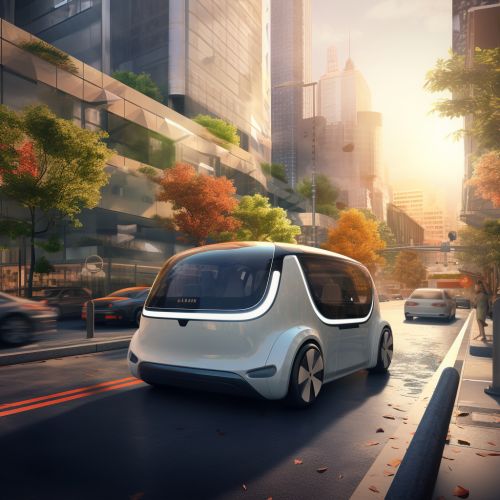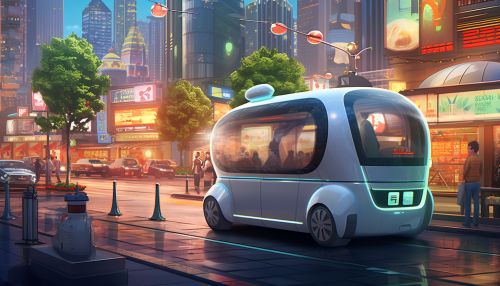Autonomous Vehicles
Overview
Autonomous vehicles, also known as self-driving cars or driverless cars, are vehicles that are capable of sensing their environment and operating without human involvement. They use a variety of techniques to perceive their surroundings, including Radar, Lidar, GPS, Odometry, and Computer Vision. Advanced Control Systems interpret sensory information to identify appropriate navigation paths, as well as obstacles and relevant signage.


History
The concept of autonomous vehicles dates back to the early 20th century, but serious research and development began in the 1980s. The DARPA Grand Challenge in the United States in 2004, 2005, and 2007 played a significant role in advancing autonomous vehicles, with several teams developing autonomous vehicles that could navigate a course in the desert.
Technology
Autonomous vehicles use various forms of technology to perceive their environment, including radar, lidar, GPS, odometry, and computer vision. These technologies work together to create a map of the environment, identify obstacles, and plan a path to the destination.
Sensors
Sensors are a critical component of autonomous vehicles. They collect data about the vehicle's surroundings, which is then processed by the vehicle's computer system to make decisions about navigation.
Radar
Radar sensors use radio waves to determine the distance, angle, and velocity of objects around the vehicle. They are particularly useful for detecting large, metallic objects and can operate in a variety of weather conditions.
Lidar
Lidar sensors use light in the form of a pulsed laser to measure distances to objects. They create a detailed, three-dimensional map of the environment, which is particularly useful for identifying non-metallic objects, such as pedestrians and cyclists.
GPS
GPS is used to determine the vehicle's location and to help plan the route to the destination. However, GPS alone is not sufficient for autonomous navigation, as it does not provide detailed information about the vehicle's surroundings.
Odometry
Odometry is used to estimate the vehicle's change in position over time. This is particularly useful when GPS data is unavailable or unreliable.
Computer Vision
Computer vision involves the use of cameras to capture images of the environment. These images are then processed to identify objects, such as other vehicles, pedestrians, and traffic signs.
Control Systems
Control systems interpret the data collected by the sensors to make decisions about the vehicle's navigation. This includes determining the vehicle's current location, planning the path to the destination, and controlling the vehicle's speed and direction.
Levels of Automation
The Society of Automotive Engineers (SAE) has defined six levels of automation, from Level 0 (no automation) to Level 5 (full automation). These levels describe the extent to which the vehicle is capable of operating without human intervention.
Level 0: No Automation
At this level, the human driver performs all driving tasks, including steering, braking, accelerating, and monitoring the environment. The vehicle may have some driver assistance systems, such as cruise control, but these do not perform any part of the driving task on a sustained basis.
Level 1: Driver Assistance
At this level, the vehicle can assist with some driving tasks, but the human driver must always be ready to take control. The vehicle may have systems that can control either steering or speed, but not both simultaneously.
Level 2: Partial Automation
At this level, the vehicle can control both steering and speed under certain conditions, but the human driver must always be ready to take control. The vehicle can also perform lane centering and adaptive cruise control.
Level 3: Conditional Automation
At this level, the vehicle can perform all driving tasks under certain conditions, but the human driver must be ready to take control when the system requests. The vehicle can monitor the environment and make decisions about when to change lanes, turn, and stop.
Level 4: High Automation
At this level, the vehicle can perform all driving tasks under certain conditions, and it does not require the human driver to take control. However, the vehicle may not be able to operate in all conditions or environments.
Level 5: Full Automation
At this level, the vehicle can perform all driving tasks under all conditions and environments. It does not require a human driver at all.
Benefits and Challenges
Autonomous vehicles have the potential to bring significant benefits, including improved safety, increased mobility, and reduced environmental impact. However, they also present several challenges, including technical, regulatory, and societal issues.
Benefits
Autonomous vehicles have the potential to significantly improve road safety by reducing human error, which is a major cause of accidents. They could also increase mobility for people who are unable to drive, such as the elderly and disabled. Furthermore, they could reduce environmental impact by optimizing driving behavior and facilitating car sharing.
Challenges
Despite the potential benefits, autonomous vehicles also present several challenges. These include technical challenges, such as the need for reliable sensors and control systems, as well as regulatory challenges, such as the need for laws and regulations that govern the use of autonomous vehicles. There are also societal challenges, such as concerns about job loss and privacy.
Future of Autonomous Vehicles
The future of autonomous vehicles is uncertain, but they are likely to become increasingly common on our roads. They have the potential to transform transportation, but this will depend on overcoming the technical, regulatory, and societal challenges.
